I feel compelled to jump into the hoo-ha that has surrounded the ‘startling’ episode of a young leopard jumping onto the bonnet of a safari vehicle – an incident which has put so many knickers into tight knots.
Let’s go back in time so that we have perspective. Leopards evolved over some three million years to stealthily hunt their prey in wooded areas, using their dappled spots to camouflage themselves in both long grass and from lofty perches. For much of that time, their main enemies would have been their close relatives – lions – as well as other large predators such as hyenas and bears. They would have happily preyed on our early ancestors, but came to respect hominids as the bipedal apes slowly established themselves as alpha predators who would kill the powerful cats to eliminate a threat to themselves. In more recent years, leopards have had to adapt to Homo sapiens suddenly coveting their skins as revered tribal wear, and later, to adorn the floors and walls of dwellings in distant lands. The method of killing them changed from spears at close quarters to weapons that thundered from a safe distance – requiring none of the bravery demanded of early hunters. Leopards developed an understandable fear of humans and concealed themselves as much as possible.
Then, in recent years, the leopard’s world changed yet again. Large numbers of humans suddenly elected to admire them for their outrageous beauty rather than slaughter them for their pelts. Three or four decades ago, the sight of a leopard’s tail disappearing into the bush was considered reward enough for most wildlife enthusiasts. But gradually, leopards realised that a truckload of humans no longer represented a threat. Generation after generation of leopards learnt from their mothers that humans were benign in many protected areas, and cubs developed an increasing trust of the noisy vehicles that surrounded them almost from the time they were born.
This has led to them becoming increasingly comfortable with game-drive vehicles. Last month, I was in the Okavango with some clients when we spotted a young male leopard who was so intent on following a scent that interested him, he ignored us. We followed his zig-zag path at a respectful distance for a good while before he went to drink from a rain-filled track in the road. To get photos of him drinking, we parked across the track in a dry spot some distance away. When he finished drinking, he non-threateningly splashed through the water towards us, and without breaking stride, passed under the vehicle and continued his mission without glancing at us.
There are some who would criticise us for not revving the engine or beating on the doors – and perhaps we should have, though that seems to me to be something of a gung-ho attitude. It is important to be able to read an animal and its intentions, and this leopard showed total disinterest in us.
This brings me to the recent incident in the Kruger National Park, where a young male leopard (little more than a cub at under two years old, I am told) exhibited unusually inquisitive behaviour. The leopard, which was feeding on a kill with its mum and a sibling, had clearly had its fill and approached a stationary safari vehicle, leapt onto the bonnet, and engaged closely with the guide and tourists. The guide remained calm, and the tourists took his lead, capturing the moment on their cameras. The curious leopard eventually disembarked without causing harm.
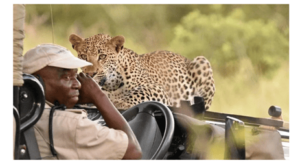
The incident, understandably, garnered significant attention on social media platforms, eliciting a spectrum of reactions ranging from admiration for the guide’s composure to concerns about safety protocols. Some individuals expressed alarm regarding the proximity allowed between the wild animal and humans, questioning whether proper safety measures were in place and whether the guide’s behaviour was appropriate. The titles of the articles – Spine-Chilling, Hair-Raising, Too Close for Comfort – reflect the general reaction to this incident, and there is no question that it was an unwelcome situation, and one that should not be encouraged.
However, there is little doubt in my mind that incidents like this will become increasingly common as animals become habituated (progressively accustomed to the presence of people and vehicles), and guides inevitably become more complacent. Good luck to you if you think that guides – particularly in private concessions where off-roading is permitted – won’t try to give their guests the best possible animal experiences. That is what their profession is all about, and it is also the expectation of the guests, who demand that their guide provides constant social media photo opportunities. A safari guide is, after all, a professional who shoulders a critical responsibility in managing interactions, interpreting animal behaviour, and implementing protocols to protect both guests and wildlife. It is an onerous obligation in an unpredictable and potentially dangerous world, where things can change in an instant.
That it will sometimes go sideways, as it did in this instance, is inevitable. That does not mean we should overreact and throw the baby out with the bathwater. In my experience – based on over forty years as a wilderness guide – the guide handled a bad situation well. Assuming that it was the first time this had occurred, he would have been taken by surprise, as any guide would have been. By the time the leopard was on his bonnet, it was too late to make sudden movements or loud noises by banging on doors or starting the engine. The leopard was simply too close for comfort, and the situation could have quickly escalated out of control. Judging from the photographic evidence, the guide sat quietly and averted his gaze to avoid eye contact – a wise move, as the cat could otherwise have interpreted a close-quarters stare as a direct challenge.
If, of course, this was not the first time this had happened to him, then he can justly be accused of being reckless with his guests’ safety and should be severely censured. This is not – and should never become – a party trick. Should a guide know that an animal is likely to break with conventional behaviour, then he should entirely avoid contact with that animal, no matter how strong the temptation to show his guests a great sighting.
The lodge whose clients were in the vehicle stated in part:
“We wish to address an unfortunate incident involving a young male leopard, that has recently displayed unusually inquisitive behaviour towards the safari vehicles. Footage has been shared showing this young leopard jumping onto the bonnet of a Hoyo Hoyo Safari Lodge vehicle. The incident took place during a sighting whilst two cubs and their mother were feeding on an impala. The situation quickly escalated when the male cub moved towards the vehicle and unexpectedly jumped up….”
The statement that the young male leopard had ‘displayed unusually inquisitive behaviour’ gives me pause. Extra care – or even total avoidance – needs to be employed if it is known that an animal is behaving out of character.
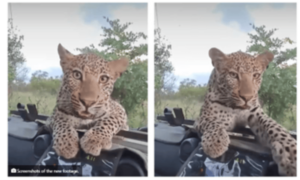
Some have legitimately called for a responsible distance from the sighting, but animals move. If the guide had anticipated that the leopard would jump onto his bonnet, then starting the engine in time to deter it would have been a justifiable action. But I suspect those leopards customarily approach the vehicle without incident, and he felt no compulsion to take defensive action. After all, he is out there in the same area every day and understands the animals he encounters on a regular basis.
On my East African adventures, I always try to keep the regulated five-metre distance from mountain gorillas – but invariably, they approach me and make direct physical contact, possibly intrigued by my hairy countenance. I assume that it was similar curiosity that caused the young leopard to investigate what was in the truck. There is nothing in the photos to show any aggression – just simple curiosity.
My recommendation is that he should be given a wide berth until he matures a bit and realises that he is not welcome to ride on the bonnet.
Habituation of animals who are fortunate enough to live in places where they don’t feel the need to fear the scourge of destructive humans requires an evolutionary adaptation – from both us and them. In this instance, the youthful leopard displayed total trust in humans and showed no aggressive behaviour. The outrage about the guide’s performance includes disapproval from theoretical armchair critics as well as enthusiastic young guides still quoting from a textbook.
We need to understand that our encounters with wild animals will fundamentally change as they become increasingly aware that we are not a threat. Nothing gives me more pleasure than getting close and personal with a wild animal – such as an impala – that no longer feels the need to fear me simply because I am human. As a result of this new relationship, we are able to watch animals behaving naturally in the bush instead of having them flee from us.
However, there is a fine line between being able to admire the wild without taming it, and it is incumbent upon guides to draw that line. We, as guides, have a responsibility to adapt our behaviour to maximise our guests’ experience while maintaining a respectful – but not fearful – attitude to all animals. Our intrusion into their world needs to be considerate, and as our new relationship continues to evolve, so too will we need to adapt to developing circumstances.

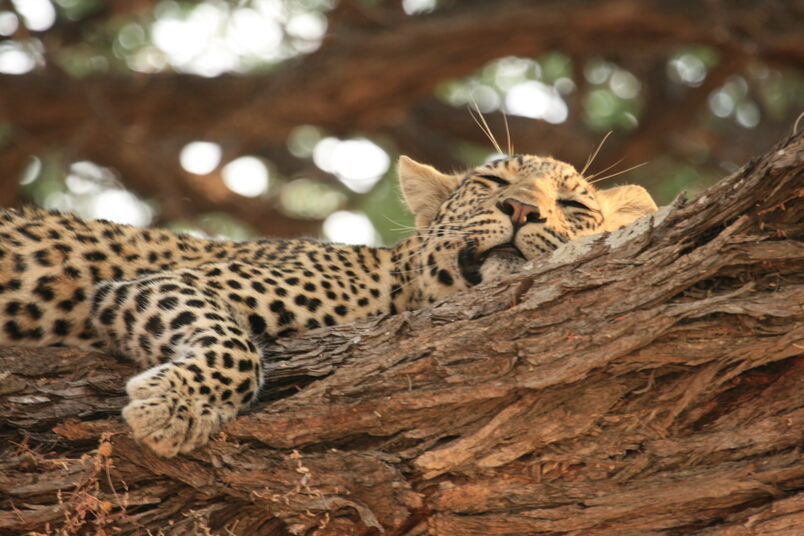
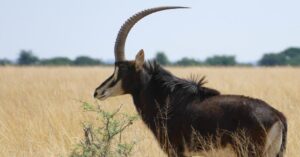
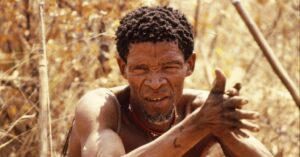
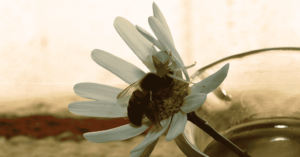
Well said. I would add we will never be able to entrust all our guides to adapt as you suggest. Unfortunately, that will result in encounters such as the inquisitive leopard that ended well and ones that do not end well. We can only encourage guides, the lodges that employ them and the schools that train them to give proper guidance.